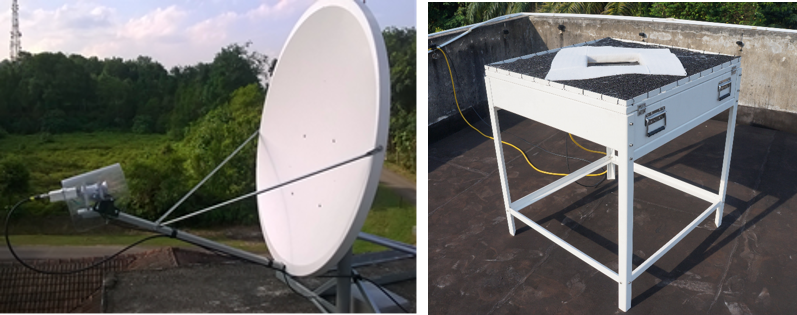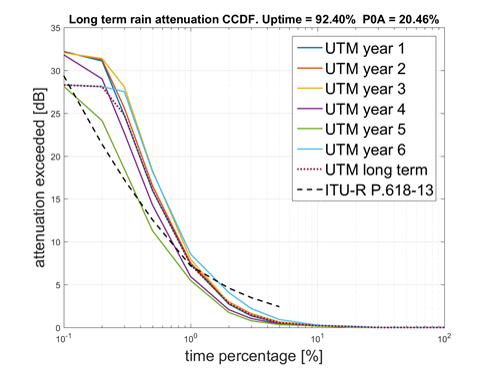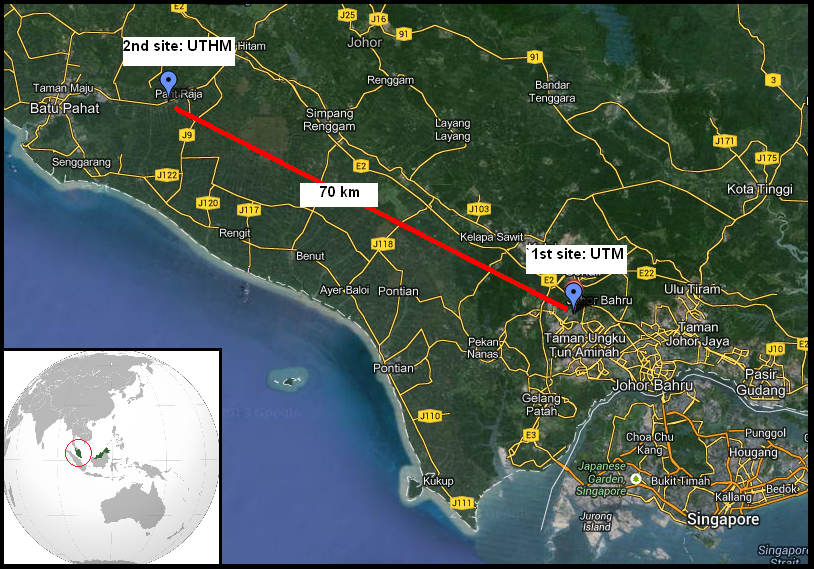-
StatusCompleted
-
Status date2022-01-05
-
Activity Code3B.024
The main objective of this activity was to improve the characterisation of the radio channel modelling and ground system requirements for the development of a Ka-band SatCom system covering tropical regions.
This includes the assessment of the accuracy of current prediction models with particular regard to statistical distribution of rain and cloud attenuation and the improvement of the statistical models for the parameters describing signal fade slope, signal fade duration and gain of site and time diversity techniques.
The results of this project were submitted to the ITU-R SG3.
The setup and operation of ground propagation terminals in tropical regions together with ancillary equipment (disdrometer, … ) reveals a number of challenges. These include the logistics, data transfer, trouble shooting actions, provision of replacement parts and others more. Thanks to the great cooperation with the local Malaysian partners, Universiti Teknologi Malaysia (UTM) and University Tun Hussein Onn Malaysia (UTHM) all these challengegs could successful be met. The below figure shows the antenna of one of the Ka-band ground propagation terminals and the 2D-Video-Distrometer (2DVD).

As a result of this measurement campaign in Malaysia, statistical analyses of propagation conditions in a tropical region have been performed over a six-year period. The statistics of rain intensity, rain attenuation, fade duration, site diversity, amplitude of scintillations and fade slope were submitted to ITU-R SG3 and can be downloaded from the website of the Correspondence Group CG-3M-2 - ITU-R SG 3 DBSG3 databank on measurements for all tables except Table VI-1 (Terrestrial Point-to-area data). As an example the below figure shows yearly and long term rain attenuation CCDFS at site UTM. The comparison with the existing ITU-R model indicates room for discussions on the model.

The analyses and statistics obtained are based on a carefully prepared experimental setup and thoroughly executed data preprocessing. The data preprocessing includes the following steps:
-
Referencing all data to a common time scale: All instruments are synchronized in advance to coordinated universal time (UTC) using network time protocol (NTP) servers.
-
Assessing data validity: The measurements are automatically analyzed in search of outliers and then visually inspected in order to check, modify and apply standard validity flags to the data (i.e. valid, invalid, doubtful…).
-
Rainfall rate computation: From tipping bucket tips and disdrometer drop size distribution measurements.
-
Template extraction: Satellite orbital instabilities and thermal drifts induce daily signal level fluctuations which are removed using an FFT in order to obtain in-excess attenuation time series. Three consecutive days are taken into account. Attenuation events are selected and excluded from the template extraction procedure (using the rainfall rate time series and by visual inspection). Only very low frequency components are subtracted from the raw measured beacon level (not filtering intervals shorter than 6 h), avoiding meteorological phenomena to be removed.
Malaysia’s climate can be classified as equatorial. Due to the geographical location, the climate in this region is characterized by uniform temperature and pressure, high humidity and abundant rainfall. The average annual amount of rain is 2340 mm.
The experimental locations for site diversity measurements are the premises of Universiti Teknologi Malaysia (UTM) (1.561° N, 103.645° E) and Universiti Tun Hussein Onn Malaysia (UTHM) (1.858° N, 103.089° E). The elevation angles of the receiving antennas are 25.49° and 26.15° respectively. The distance between the two sites is 70 km, as shown in below Figure.

In this region the propagation equipment was set up, including two ground propagation terminals, one disdrometer and a meteorological station measuring rainfall rate, air temperature, pressure, relative humidity, wind speed and wind direction.
The measurement campaign and the data analyses are successfully completed.
The results of the measurement campaign and data analyses has already been submitted to the ITU-R SG3.



